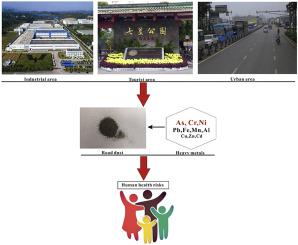Environmental Pollution ( IF 7.6 ) Pub Date : 2020-08-15 , DOI: 10.1016/j.envpol.2020.115419 Asfandyar Shahab 1 , Hui Zhang 1 , Habib Ullah 2 , Audil Rashid 3 , Saeed Rad 1 , Jieyue Li 1 , He Xiao 1

|
Road dust samples from industrial, urban, and tourist areas of the international tourist city of Guilin, China, were collected to study the concentration, spatial distribution, pollution level, and health risk of potentially toxic elements (PTEs) using an array-based risk assessment model from the United States Environmental Protection Agency. The geoaccumulation index (Igeo), ecological risk index, and spatial interpolation were used to investigate the road dust pollution level. The results indicated that apart from Ni and Al, the concentration of all the heavy metals (Pb, Zn, Ni, Cu, Cr, Cd, Fe, Mn, and As) were markedly higher than the corresponding background values in the three functional areas. Based on the Igeo, the study area had an uncontaminated to moderate pollution level, and the industrial area was slightly more polluted and posed a greater ecological risk than the urban and tourist areas. Comparatively, Pb, Zn, and Cu exhibited higher pollution levels in the three functional sites. Hotspots of PTEs were more concentrated in urban and industrial areas than in tourist areas. Furthermore, the health risk model revealed significant non-carcinogenic risks to children from As in urban, industrial, and tourist areas as the hazard quotients (1.64, 2.04, and 1.42, respectively) exceeded the threshold standard of 1.00. The carcinogenic risk via ingestion (RIing) illustrated significant risks to children from Cr, As, and Ni because the RIing values were considerably higher than the threshold standard (1.00E-6 to 1.00E-4) in the three functional areas. However, no cancer risk was observed from the dermal and inhalation pathways.















































 京公网安备 11010802027423号
京公网安备 11010802027423号